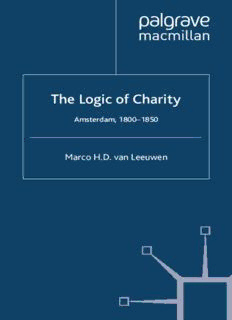
The Logic of Charity: Amsterdam, 1800–1850 PDF
Preview The Logic of Charity: Amsterdam, 1800–1850
The Logic of Charity Amsterdam, 1800–1850 Marco H.D. van Leeuwen The Logic of Charity This page intentionally left blank The Logic of Charity Amsterdam, 1800–1850 Marco H. D. van Leeuwen Senior Researcher Netherlands Economic History Archives Amsterdam The Netherlands Translated by Arnold J. Pomerans First published in Great Britain 2000 by MACMILLAN PRESS LTD Houndmills, Basingstoke, Hampshire RG21 6XS and London Companies and representatives throughout the world Acatalogue record for this book is available from the British Library. ISBN 978-1-349-40200-7 ISBN 978-0-230-59700-6 (eBook) DOI 10.1057/9780230597006 First published in the United States of America 2000 by ST. MARTIN’S PRESS, INC., Scholarly and Reference Division, 175 Fifth Avenue, New York, N.Y. 10010 ISBN 978-0-312-22853-8 Library of Congress Cataloging-in-Publication Data Leeuwen, Marco H. D. van, 1958– [Bijstand in Amsterdam, ca. 1800–1850. English] The logic of charity : Amsterdam, 1800–1850 / Marco H.D. van Leeuwen ; translated by Arnold J. Pomerans. p. cm. Includes bibliographical references and index. ISBN 978-0-312-22853–8 (cloth) 1. Public welfare—Netherlands—Amsterdam—History—19th century. 2. Amsterdam (Netherlands)—Social policy. I. Title. HV310.A6L4413 1999 362.9492'392—dc21 99–40411 CIP ©Marco H. D. van Leeuwen 2000 Softcover reprint of the hardcover 1st edition 2000 All rights reserved. No reproduction, copy or transmission of this publication may be made without written permission. No paragraph of this publication may be reproduced, copied or transmitted save with written permission or in accordance with the provisions of the Copyright, Designs and Patents Act 1988, or under the terms of any licence permitting limited copying issued by the Copyright Licensing Agency, 90 Tottenham Court Road, London W1P0LP. Any person who does any unauthorised act in relation to this publication may be liable to criminal prosecution and civil claims for damages. The author has asserted his right to be identified as the author of this work in accordance with the Copyright, Designs and Patents Act 1988. This book is printed on paper suitable for recycling and made from fully managed and sustained forest sources. 10 9 8 7 6 5 4 3 2 1 09 08 07 06 05 04 03 02 01 00 To Henk and Joyce This page intentionally left blank Contents List of Tables ix List of Figures xi List of Plates xii List of Maps xiii Preface xiv Acknowledgements xv 1 A Simple Model of Poor Relief in Preindustrial Europe 1 1.1 Simple questions and general principles 1 1.2 The elites and poor relief 5 1.3 The poor and poor relief 13 1.4 Interdependence 22 1.5 The effects of poor relief 24 1.6 Procedure 28 1.7 Summary 31 2 Poverty and Riches 36 2.1 General outline 36 2.2 Income structure 41 2.3 Social segregation 43 2.4 The organization of poor relief 49 2.5 Summary 53 3 Poor Relief as a Control Strategy 54 3.1 Charity administrators 54 3.2 Relief policies 68 3.3 Collective interests 73 3.4 Individual interests 83 3.5 Who paid the bill? 91 3.6 Summary 96 4 Poor Relief as a Survival Strategy 99 4.1 Registration 99 4.2 Recipients of benefits 103 4.3 Type and extent of relief 118 vii viii Contents 4.4 Fraud and its prevention 133 4.5 Summary 142 5 The Role of Poor Relief in Society 144 5.1 Alternative control strategies 144 5.2 Alternative survival strategies 162 5.3 Interdependence 176 5.4 Summary 182 6 Concluding Remarks 185 6.1 Which groups provided poor relief and why? 185 6.2 Which groups received poor relief and why? 188 6.3 What were the effects of poor relief on society? 189 6.4 How useful was the simple model of poor relief in preindustrial Europe? 190 Appendix A: The Anatomy of Charitable Power 192 Appendix B: A Short Survey of European Charity: Recipients and the Value of their Relief 196 Notes 201 Archives Consulted 221 References 222 Index 235 List of Tables 2.1 Number of paupers based on one-off donations in 1794–1853 42 2.2 Distribution of heads of households by income in 1855 43 3.1 Interlocking directorates of charity administrators during the first half of the nineteenth century 55 3.2 Social status of charity administrators during the first half of the nineteenth century 57 3.3 Occupation of charity administrators in 1851 59 3.4 Incomes of charity administrators in 1854 60 3.5 Occupation of Reformed deacons, 1821–54 61 3.6 Waiting time for Reformed deacons by occupation, 1826–54 62 3.7 Age on taking office as charity administrator, 1840–54 65 3.8 Term of office as charity administrator during the first half of the nineteenth century 65 3.9 Service as a charity administrator as a stepping stone to political office during the first half of the nineteenth century 85 3.10 Income and expenditure of the five leading poor-relief institutions, 1829–54 92 4.1 Number of indoor- and outdoor-relief recipients by type of institution, 1829–54 103 4.2 Number of paupers on outdoor relief per charity, 1829–54 104 4.3 Adults receiving poor relief from the Ashkenazi Charity in 1809 107 4.4 Newly registered adults granted poor relief by the Municipal Charity (1808–54) and by the Lutheran Charity (1829–54) 108 4.5 Port-related work by men on relief and by the total male labour force 110 4.6 Most common occupations of adults drawing relief from the Ashkenazi Charity in 1809 111 4.7 Most common occupations of newly enrolled adults drawing relief from the Municipal Charity (1830–54) and from the Lutheran Charity (1837–54) 112 ix
